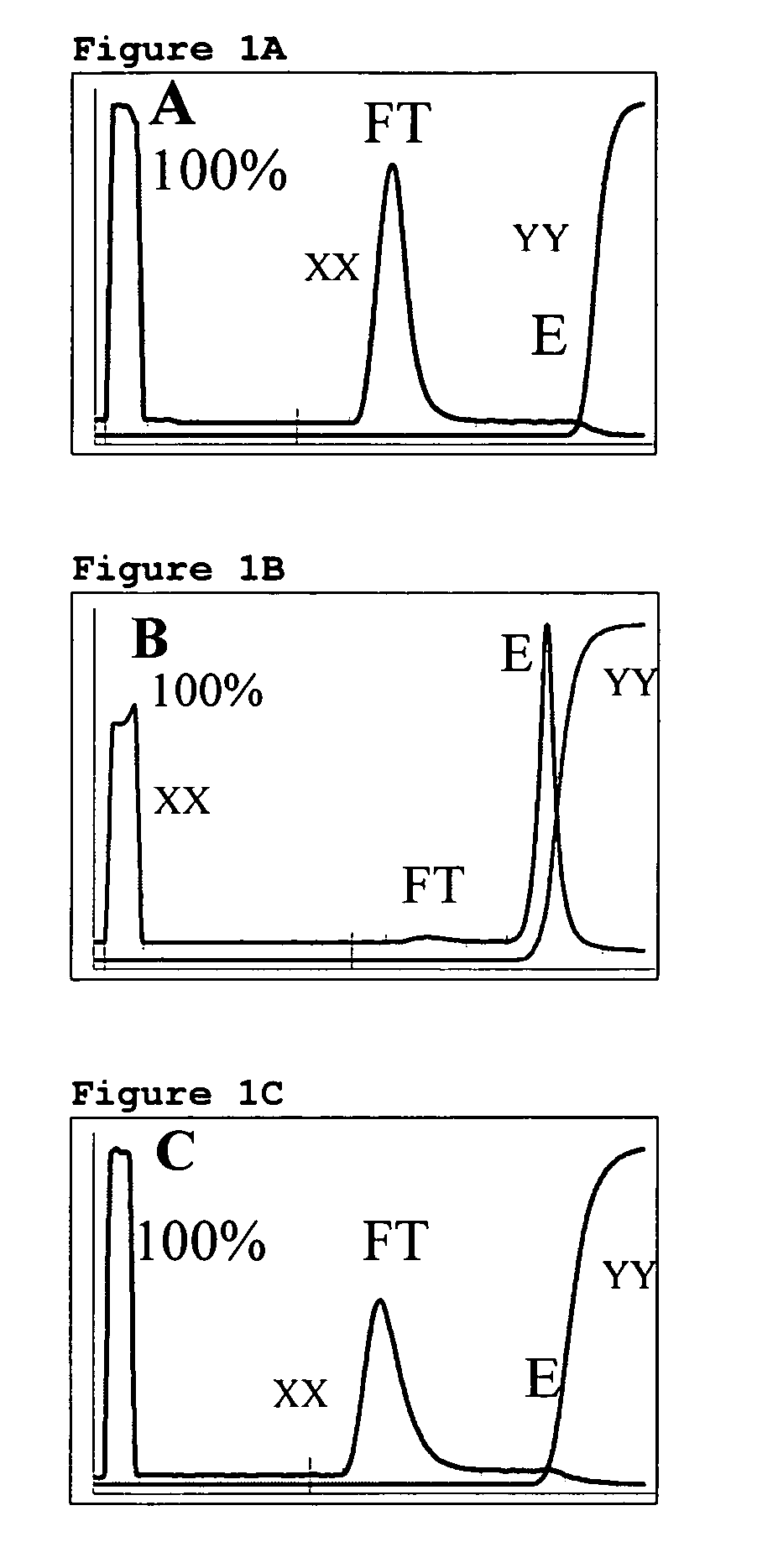Method for selective removal of a substance from samples containing compounds having nucleic acid structure
a nucleic acid structure and sample technology, applied in the field of purification of a desired substance comprising nucleic acid structure, can solve the problems of increasing the risk of conformational changes, irreversible denaturation/degradation, and no publications disclose the use of separation media
- Summary
- Abstract
- Description
- Claims
- Application Information
AI Technical Summary
Benefits of technology
Problems solved by technology
Method used
Image
Examples
example 1
Anion Exchanger in Particle Form with a Lock on the Particles
[0110] A. Allylated crosslinked agarose particles (allylated base matrix). Cross-linked agarose (90 μm particles) prepared by reaction between epichlorohydrin and agarose in the presence of NaOH according to Porath et al (J. Chromatog. 60 (1971) 167-77 and U.S. Pat. No. 3,959,251) was reacted with allylglycidyl ether with NaOH as a base to a allyl level (CH2═CHCH2OCH2CHOHCH2—) of 0.18-0.30 mmole / ml). This base matrix has a porosity which is similar to Sepharose 4B FF (Amersham Pharmacia AB, Uppsala, Sweden).
[0111] B. Introduction of a lock on allylated crosslinked agarose particles. 25 g vacuum drained allylated particles from A with an allylic content of 0.29 mmol / ml gel was charged together with 0.6 g anhydrous sodium acetate and 50 ml de-ionized water in 100 ml beaker fitted with a propeller stirrer. 0.18 ml bromine was added drop-wise under rapid stirring.
[0112] The brominated gel was then washed with plenty of de-i...
example 2
Reference Matrix Without Lock (Naked Matrix) Functionalized with Tris Ligand
[0122] A. Allylated crosslinked agarose particles (allylated base matrix). This base matrix was prepared in the same way as in Example 1A. The allyl-ligand density was determined to 0.26 mmol / ml matrix.
[0123] B. Coupling of Tris (tris(hydroxymethyl) amine). 10 ml vacuum drained allylated gel from example 2A, 1.2 g sodium sulfate and 50 ml distilled water was mixed in 100 ml beaker fitted with a propeller stirrer. Bromine was added dropvise under rapid stirring until the slurry turned permanently yellow.
[0124] The gel was washed with plenty of water. After vacuum draining on a glass filter funnel the gel was transferred to a three necked 25 ml Bellco flask with a hanging magnetic stirrer which already contained 15 g Tris and 15 g distilled water. The reaction was carried out at 60° C. over night.
[0125] The pH of the reaction mixture was adjusted to 7 with dilute hydrochloric acid. A washing step using ple...
example 3
Chromatographic Experiments with Purified Plasmids
I. Materials
[0127] Separation media: Lock particles according to example 1 (separation medium A) and particles without lock according to example 2 (separation medium B).
[0128] Plasmid preparation: E. coli cells harbouring plasmid PXL 2784 (size=6.3 kbp) were lysed according to the standard alkaline lysis method of Birnboim (Birnboim et al., Nucleic Acids Res. 7 (1979) 1513-1523; and Birnboim, Meth. Enzymol. 100 (1983) 243-255). The sample was not treated with RNAse.
[0129] The purified plasmid PXL 3096 (2.5 kbp) was purified by using essentially hydroxy apatite chromatography while PXL 2784 (6.3 kbp) was prepared here in Uppsala using the Qiagen Kit (Qiagen) which meant RNAse treatment.
[0130] Equilibration buffer (A): 10 mM Tris-HCl, 1 mM EDTA, pH 8.0
[0131] Elution buffer (B): 1 M NaCl in Buffer A, pH 8.0
II. Chromatography
[0132] A column (HR 10 / 3 (Amersham Pharmacia Biotech AB, Uppsala, Sweden) containing separation medium A...
PUM
| Property | Measurement | Unit |
|---|---|---|
| Structure | aaaaa | aaaaa |
| Affinity | aaaaa | aaaaa |
| Nucleic acid structure | aaaaa | aaaaa |
Abstract
Description
Claims
Application Information
 Login to View More
Login to View More - R&D
- Intellectual Property
- Life Sciences
- Materials
- Tech Scout
- Unparalleled Data Quality
- Higher Quality Content
- 60% Fewer Hallucinations
Browse by: Latest US Patents, China's latest patents, Technical Efficacy Thesaurus, Application Domain, Technology Topic, Popular Technical Reports.
© 2025 PatSnap. All rights reserved.Legal|Privacy policy|Modern Slavery Act Transparency Statement|Sitemap|About US| Contact US: help@patsnap.com

